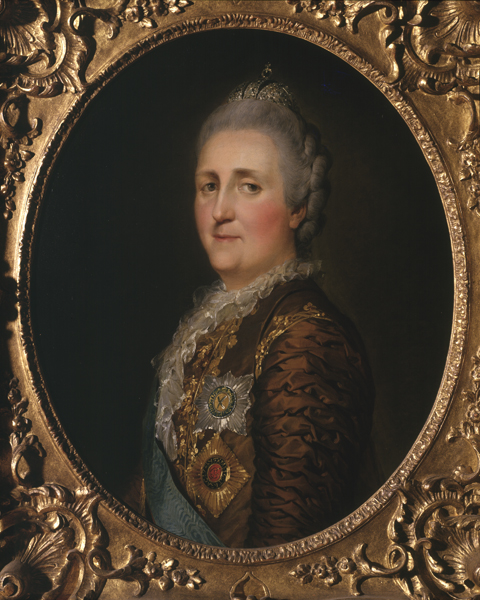Passion of the Empress: Catherine the Great's Art Patronage
A dazzling array of decorative art in gold, silver, porcelain, and enamel reveals the power and patronage that marked the reign of Catherine the Great, one of Russia’s foremost art collectors and shrewdest political and cultural leaders.
 Driven by a thirst for knowledge and a quest for the throne, Catherine propelled herself to the role of Empress through the sheer power of her intellect, cunning, and resolve. For thirty-four years, she reigned over a golden age of Russian culture, founding what would become the State Hermitage Museum and transforming St. Petersburg into one of Europe’s cultural centers. Passion of the Empress: Catherine the Great’s Art Patronage presents a selection of finely-crafted decorative art pieces to explore how the famous tsarina masterfully blended traditions of Byzantine art with the Western neoclassical style that was a hallmark of the Enlightenment.
Driven by a thirst for knowledge and a quest for the throne, Catherine propelled herself to the role of Empress through the sheer power of her intellect, cunning, and resolve. For thirty-four years, she reigned over a golden age of Russian culture, founding what would become the State Hermitage Museum and transforming St. Petersburg into one of Europe’s cultural centers. Passion of the Empress: Catherine the Great’s Art Patronage presents a selection of finely-crafted decorative art pieces to explore how the famous tsarina masterfully blended traditions of Byzantine art with the Western neoclassical style that was a hallmark of the Enlightenment.
With the stunning Buch Chalice as the centerpiece, twenty-seven works from Hillwood’s Russian imperial art collection form the foundation of the exhibition. Other lenders to the exhibition include the Metropolitan Museum of Art, the Walters Art Museum, Dumbarton Oaks, The Birmingham Museum of Art, and private collections.
When she took the throne in 1762, Catherine was determined to change the perception of Russia throughout Europe as a culturally lacking empire. Having lived at court since 1744, when she became engaged to the future Peter III, while educating herself about Russian culture, language, and the Orthodox Church, Catherine quietly developed her own sense of style. Her immersion in Russian tradition did not preclude the savvy Empress from maintaining ties with Western Europe. Correspondence with the French philosophes in particular eventually strengthened French taste in Russia and enabled Catherine to foster the arts, science, and education.
Though she is best known for collecting thousands of paintings, Catherine commissioned splendid metalwork, porcelain, glasswork, and books for her own use and as gifts for courtiers. It is in these objects that the blending of Byzantine and classical influences shows Catherine’s desire to forge a new direction for Russian culture and align it with the West. Many of the objects in the exhibition bring focus to Catherine’s use of ancient and medieval carved cameos and intaglios and her incorporation of those into her commissions for new works of art. The empress not only shared the Enlightenment sentiment that carved gems were important pieces of the past, but she was also aware of the power associated with the practice of collecting cameos.
The most exquisite example of this intermingling is the Buch Chalice. Commissioned in 1790, Iver Windfeldt Buch produced two liturgical sets, each comprising a chalice and several other pieces necessary for celebrating the Divine Liturgy. To construct the sets, Catherine provided Buch with gold and diamonds from the State Treasury and carved gems representing scenes from the life of Christ, saints, and angels, which came from her private collection. Of the gems, a thirteenth-century Byzantine cameo of the Archangel Michael is the oldest. The remaining ones are mostly contemporary. Catherine presented a set, including this chalice, to the Trinity Cathedral in the Aleksandr Nevskii Monastery in St. Petersburg on August 29, 1791.
the Divine Liturgy. To construct the sets, Catherine provided Buch with gold and diamonds from the State Treasury and carved gems representing scenes from the life of Christ, saints, and angels, which came from her private collection. Of the gems, a thirteenth-century Byzantine cameo of the Archangel Michael is the oldest. The remaining ones are mostly contemporary. Catherine presented a set, including this chalice, to the Trinity Cathedral in the Aleksandr Nevskii Monastery in St. Petersburg on August 29, 1791.
Other highlights of the exhibition include a glass cameo of Catherine II in the Guise of Minerva, based on a Siberian jasper cameo carved by Catherine’s daughter-in-law, Maria Feodorovna, depicting Catherine as the goddess Minerva wearing a helmet decorated with a winged sphinx crown and laurel wreath; a late 17th-century censer that is one of the most stunning examples of metalwork in Hillwood’s collection; and pieces from the Orlov Porcelain Service, the expansive set made at Catherine’s request by the Imperial Porcelain Factory for Count Grigory Grigoryevich Orlov (1734-1783).
The exhibition was organized by the Georgia Museum of Art (titled Exuberance of Meaning: The Art Patronage of Catherine the Great). A full-color catalogue accompanies the exhibition with essays by organizing curator Asen Kirin, associate professor of art and associate director of the Lamar Dodd School of art at the University of Georgia, and Dr. Scott Ruby, Hillwood’s associate curator for Russian and Eastern European Art.
Sponsorship
The exhibition is supported by the Marjorie Merriweather Post Foundation, Bonhams, Ellen MacNeille Charles, Mr. and Mrs. Dale Church, Cyril Geacintov, Ph.D., Elizabeth Trey, and a memorial gift in honor of all of their parents from the Davison and Cheremeteff families. All exhibitions and programs are funded in part by the U.S. Commission on the Fine Arts through the National Capital Arts and Cultural Affairs program.
Organized by the Georgia Museum of Art, University of Georgia, Athens. The exhibition is supported by grants from the Frances Wood Wilson Foundation, Samuel H. Kress Foundation, and the W. Newton Morris Charitable Foundation, and by Mr. and Mrs. Fritz Lyons Felchlin, Mr. and Mrs. James T. Mills, Jr., A La Vieille Russie, Inc., and the Friends of the Georgia Museum of Art.


